| Risk Fleet:
German Battleships
By Mike Bennighof, Ph.D.
July 2024
 We’ve published a great many alternative history titles, but I don’t count Great War at Sea: Risk Fleet among them. On the one hand, it sends a fleet into action that never really existed. But on the other, it displays the fleet that would have existed had some mis-conceptions by historians and other writers actually been true. It’s a counter-factual rather than an alternative history, based on “what if inaccurate histories had actually been accurate?” We’ve published a great many alternative history titles, but I don’t count Great War at Sea: Risk Fleet among them. On the one hand, it sends a fleet into action that never really existed. But on the other, it displays the fleet that would have existed had some mis-conceptions by historians and other writers actually been true. It’s a counter-factual rather than an alternative history, based on “what if inaccurate histories had actually been accurate?”
The historiography of Anglo-German antagonism is pretty well-developed, and to be fair those historians who delve deeply into the subject for the most part recognize that the so-called naval arms race was not a leading factor in Britain’s march to war. Rather, it was the perception of such an arms race, promoted by the Vickers-Armstrong arms combine to gin up business, that stoked war fever in Britain. Risk Fleet therefore can't be called a radical departure from current historiographical norms; it simply asks what sort of fleet Germany could have built had a full effort been undertaken, with the shipyards and steel mills working steadily to build battleships and supporting vessels.
In the first years of the 20th Century, Imperial Germany had six shipyards building heavy warships: the Imperial dockyards at Wilhelmshaven and Kiel, and the private yards AG Vulkan in Stettin, Germaniawerft in Kiel (a Krupp subsidiary), Blohm & Voss in Hamburg and Schichau in Danzig. AG Weser of Bremen joined them a few years later, followed by Howaldtswerke of Kiel and finally a new AG Vulkan yard in Hamburg. They all received plentiful business from the Imperial Navy, but had sufficient capacity beyond that to build big ocean liners and to solicit orders for dreadnoughts from foreign navies.
Risk Fleet is an expansion for Great War at Sea: Jutland Second Edition. It includes 70 new die-cut, silky-smooth ship pieces and 45 new scenarios so you can play with them. The new ships are those that could have been constructed in a real naval arms race. The pieces have been thoroughly re-done for Risk Fleet (many appeared in the old High Seas Fleet book), with about a third of them replaced and the remainder given completely new, sharper artwork to match our supplier's crisp printing process.
Today we’ll take a look at the core of the pieces: additional German battleships.
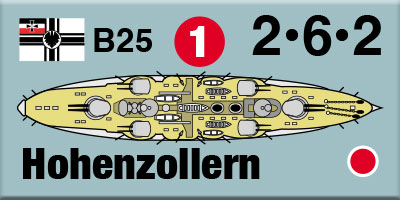
The 1904 semi-dreadnought design clearly drew heavily on the Deutschland class pre-dreadnought, herself a slightly improved version of the preceding Braunschweig class. She carried a pair of 280mm (11-inch) guns in twin turrets fore and aft, just like Deutschland. She replaced the 170mm (6.7-inch) mounted in casemates on Deutschland with eight 240mm (9.4-inch) guns, the same weapons that had served as the main armament of the just-completed Wittelsbach class of battleships.
The design specifications claimed that this semi-dreadnought would make almost 20 knots, compared to 18 for Deutschland, on the same machinery as Deutschland despite displacing 1,000 tons more than the pre-dreadnought. It seems unlikely that the ship would have actually achieved that goal, and to meet this new fleet speed the designers would have had to increase the ship’s size to fit a larger power plant, or switch from reciprocating engines to turbines. While the British fitted their Dreadnought with turbines, German designers resisted this innovation and would not use turbines to power battleships until the Kaiser class, their third class of dreadnoughts. In the game we denied the ship (and the "dreadnought" version below) the benefit of the claimed 20-knot speed (both have a speed of 1-slow in the game).

Soon after the semi-dreadnought was sketched – a full set of plans was never prepared – a variant with all big guns was also presented. This ship replaced the 240mm twin mounts with single 280mm guns, for a broadside of four heavy guns and a total of eight. She appears to have otherwise been very similar to the semi-dreadnought, with her single turrets raised a deck higher than in the semi-dreadnought to allow casemate-mounted secondary guns to be placed beneath them, which likely would have been proven a very bad idea in action.
A third alternative, with dual 280mm turrets in place of the single mounts, would eventually become Germany’s first dreadnought, the Nassau class. Siegfried Breyer argues that the delay in building the first class of German dreadnoughts derived from the desire to build the best possible ships, but that doesn’t hold up to close examination. While Nassau is markedly different from Deutschland, one can trace the design’s evolution through the semi-dreadnought and early dreadnought phases to show incremental rather than revolutionary changes. And for all the extra time supposedly spent on the design, Nassau was not a particularly good ship.
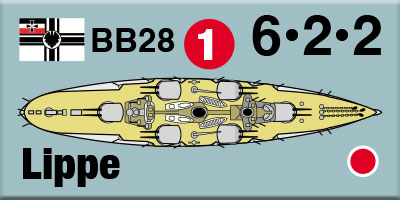
In Risk Fleet the High Seas Fleet receives five examples each of the 1904 semi-dreadnought and the 1905 miniature dreadnought. Neither is a very good fighting ship, but then, neither are the German pre-dreadnoughts from which they are derived. Their saving grace is their tough construction, and they’re going to need it as they’re out-gunned by British pre-dreadnoughts, let alone the new dreadnought battleships. Germany was probably better off without them.
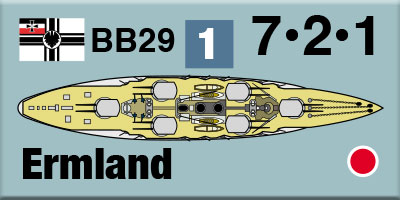
The High Seas Fleet does receive more useful ships. The five-ship class is assumed to be the new standard for an Empire attempting to challenge British naval supremacy. Lippe is the fifth ship of the Nassau class and Ermland the fifth of the Helgoland class (all of the good province names were already taken). The Kaiser class that followed had five ships, with one of them (Friedrich der Grosse) designated as the fleet flagship. So there are no additional class members included. There is a fifth König, here named Max Josef after the first king of Bavaria.

At that point, German dreadnought construction paused for a year, with only one battleship laid down in 1912 (Kronprinz, her intended 1911 start date at Germaniawerft delayed by abortive plans to fit a diesel “cruising engine” to Prinzregent Luitpold, the ship preceding her on the slipway). German naval leaders had finally realized that the British had no intention of blithely steaming into the Helgoland Bight so that the “risk fleet” could dash out to sink some of them. The distant blockade strategy overturned German naval thinking far more decisively than had the advent of the Dreadnought.
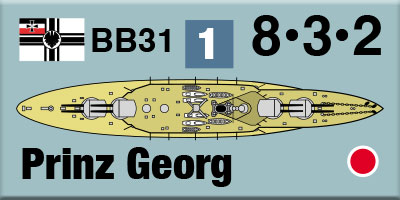
Had Germany continued the pace of dreadnought construction, the 1912 dreadnought would have carried eight 350mm (13.8-inch) guns in twin turrets, and shows herself a clear evolution of the preceding König class – at least in the design proposals, which were never formally accepted. Risk Fleet includes five examples of this class, all named for German military heroes. It’s a well-balanced ship, with somewhat less firepower than the contemporary British “super dreadnoughts” but, like other German dreadnoughts, they are substantially tougher to sink than their British peers.

When the Germans returned to building battleships – they did construct new battle cruisers during the pause – it was at a greatly reduced pace, with only two ships ordered for each year in 1913 and 1914. Had the attempt to challenge Britain continued, it seems reasonable that each year would have seen four orders instead (a step back from five in light of increased orders for battle cruisers).
Daily Content includes no AI-generated content or third-party ads. We work hard to keep it that way, and that’s a lot of work. You can help us keep things that way with your gift through this link right here.
One of the initial proposals for the next class of battleships called for a move from twin to triple turrets, retaining the 350mm guns of the 1912 dreadnought. This would be rejected in favor of what became the Bayern class. We’ve placed four units of this 12-gun ship in 1913, and all four ships of the Bayern class in 1914.

Finally, we have three odd-number battleships, starting with the Greek battleship Salamis, under construction at A.G. Vulkan when the war began. She would never be completed (even though work continued until the end of 1914, months after the war began). She appears in Jutland as Wrede, but has the wrong ship drawing. We fixed that in Risk Fleet.
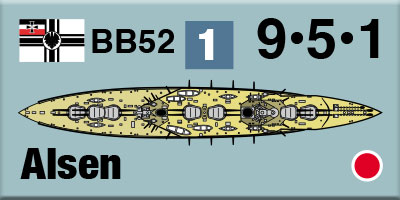
And then we have Winston Churchill’s nightmare: the two Ottoman dreadnoughts nearing completion in British shipyards in August 1914, delivered to their Turkish crews and promptly sailed across the North Sea to be presented to the High Seas Fleet. This was not very likely, but Churchill claimed this as justification for seizing the ships, so we’ve included them here.
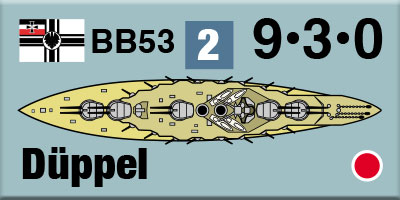
Along with the additional ships, there’s another supposition: minimal delays of construction in 1906 and 1912, moving the availability of ships forward as well. That doesn’t by itself add any additional pieces to the game, beyond what’s described here, but it does make some German ships available earlier than their historical commissioning dates. The years cited above are the actual construction dates, so rather than a 1913 start date for the first ship of the Bayern class, for example, we’re positing that all four could have been ordered in 1912 and laid down the following year, just like their British equivalents.
All of this battleship construction would have been required supporting cruisers for the High Seas Fleet, and would not have gone by without a British response. We’ll look at the additions to the German Scouting Force, and to the Grand Fleet, in further installments.
You can order Risk Fleet right here.
Beyond Jutland
Risk Fleet
Journal No. 38: Alternative Dreadnoughts
Retail Price: $54.98
Package Price: $45.00
Gold Club Price: $36.00
You can journey Beyond Jutland right here.
Sign up for our newsletter right here. Your info will never be sold or transferred; we'll just use it to update you on new games and new offers.
Mike Bennighof is president of Avalanche Press and holds a doctorate in history from Emory University. A Fulbright Scholar and NASA Journalist in Space finalist, he has published a great many books, games and articles on historical subjects; people are saying that some of them are actually good.
He lives in Birmingham, Alabama with his wife, three children, and his new puppy. His Iron Dog, Leopold, was a good dog.
Daily Content includes no AI-generated content or third-party ads. We work hard to keep it that way, and that’s a lot of work. You can help us keep things that way with your gift through this link right here.
|
